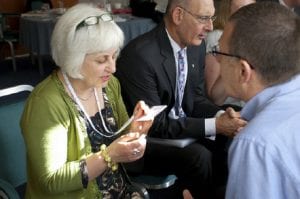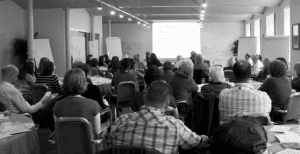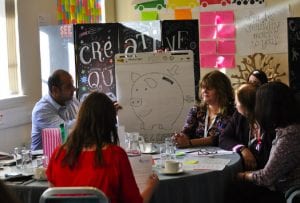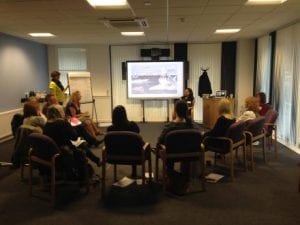Ellen Daly from Iriss reflects on the Champion Network from its beginnings in 2009 until the present.
Part of my work over the last year or so has involved thinking about ‘what next?’ for our champion network. Our ‘champs’ have been an invaluable support to us over the years and have been a source of ideas, inspiration and guidance. In order to help my thinking, I ended up writing a history of the champion network to reflect on where we’ve come from, we are now and where to go next.
Phase 1: 2009 – 2010 (Set-up)
The champion network was an idea that Alison Petch introduced when she joined Iriss as Director in 2009. The idea was based on the ‘link officer’ model at Research in Practice for Adults (Ripfa), Alison’s previous organisation. Link officers were brought together annually for a residential event as a reward for their contribution over the year. Securing champions was a fundamental function of our engagement in 2009 – it was a way for us to raise our profile in the sector; source project partners; raise awareness of our resources; get people to our events; and importantly, get advice and guidance on our direction.
The network started by engaging with those in learning, development, research and training-type roles in each local authority. We quickly had champions in each of the local authorities and each one was allocated a contact person at Iriss.
October 2010
The first annual residential event, took place at the beautiful New Lanark Mill Hotel. This event focused on exploring the champion role, showcasing some of Iriss’s work and getting to know each other.
Phase 2: 2011 – 2013 (Growth)
The champion network was extended to include some key third and private sector organisations. The network was probably at its largest during this phase with up to about 68 champions. This made it difficult to resource and ensure a consistent level of engagement across the network.
Three annual two-day residential events were held at New Lanark Mill Hotel during this phase.
September 2011
During the two days we showcased some of the work of the champions, explored self-directed support, personal outcomes and integration; and used the Futures Thinking Tool.
October 2012
This event explored a range of areas including harnessing community capacity and micro-enterprise; the Evidence Explorers project; the Pilotlight programme; and ‘scaling out’, from piloting to embedding.
Citizen champions
In 2012, we also explored the idea of developing ‘citizen’ champions to engage unpaid carers and people who access support. Again, this was based on a Ripfa model – they had a reference group of people with experience of support. We got advice from other organisations about the best way to go about this (including Scottish Commission for Learning Disability, Independent living in Scotland and a member of the Carer and User Group at the University of Dundee). At one stage, we had three citizen champions with experience of support. The idea was that we would develop the role remit with them but ultimately the demands of caring and work made it difficult for them to sustain their involvement.
November 2013
The event featured a session led by one of our champions on integration; creative methods to stimulate and consolidate change; co-design experiences from the Pilotlight programme; and an un-conference session to explore topics requested by champions.
Phase 3: 2014 (Review)
A review of the champion network was undertaken in January 2014. This involved trying to reconnect with some of the champions we hadn’t been in touch with for a while, and trying to replace those who had changed roles, moved on or who wanted to pass the champion role to another colleague. During this phase we concentrated on consolidating rather than growing the network.
September 2014
We ran two regional events for champions in September. The participants at each event got a chance to bring topics of interest to the table. These included supervision (which linked to the developing Iriss project, Leading change in Supervision); processes and systems that support the implementation of self-directed support; and Personal Learning Networks – use of the web and social media for workplace learning. Discussions also helped to inform the development of Iriss’s strategy 2015-18, which included a session on contribution analysis.
Overall, Champions saw the events as great opportunities to share ideas and make connections. People came away with leads to follow-up on and in some cases, fired up to address a challenge.
November 2014
The annual event went ahead in November at New Lanark Mill. Day one focused on Imagining the Future and day two on topics including older people, integration and contribution analysis.
Phase 4: 2015 / 16 (Rethink)
A new logic model was developed in June 2015 to look again the network in light of the findings of the Contribution Analysis work. As part of this work a case study on the network had been developed which highlighted some challenges and recommendations.
Another key change in 2015 was to rethink the annual two-day residential event at New Lanark Mill usually held in the Autumn. We recognised that while the annual event energised the group, provided inspiration, focus and a direction of travel, the challenge lay in what happened between the yearly events. How could we keep momentum? Could we spread the resource we spent on the event more evenly across the year? We didn’t want to go a year without a ‘champions event’ so we organised a one-day exploratory session called ‘Engagement, change and risk through an implementation lens’ in March 2016. The event was invite-only and champions were given priority to attend. Led by Melissa Van Dyke, the National Expert Advisor on Implementation with CELCIS, the session aimed to introduce Implementation Methodology as a frame for working with some of the challenges posed by change and risk. The session was well received and it was great to connect with some of our champions.
What’s next?
We’re in the process of ironing out details of a new approach which will maintain what was great about the champion network while addressing the challenges. Watch this space!







